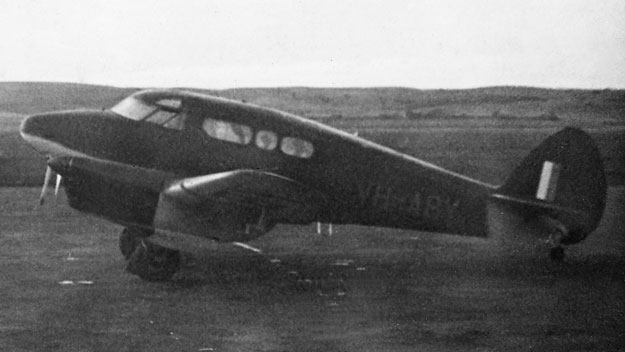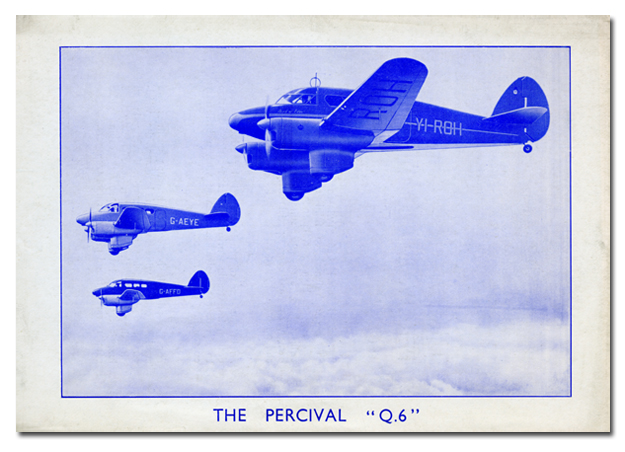A direct result of the inquiry into the crash of the Douglas DC-2 Kyeema which struck Mount Dandenong on 25 October 1938 was a Government instruction for the Civil Aviation Board to calibrate the first generation of radio navigation aids installed in Australia. The Aeroplane of 22 June 1938 reported that the Civil Aviation Board had also recommended the purchase of a Lockheed (model unstated) for the carriage of Ministers following considerable criticism of the indiscriminate use of RAAF aircraft. The CABís preference for an American aircraft for these tasks was refused by Federal Cabinet which insisted on a British purchase.
In May 1938 CAB announced the purchase of a new Percival Q.6 for a price of £7,200 (Australian). It was the first of its type in the country and was the latest in comfort and performance in pre-war British light aeroplanes. The aircraft was shipped to Australia on S.S. Wairangi, reaching Melbourne on 12 July 1939. The aircraft was registered on 20 July and assembled at Essendon Aerodrome the following month. On 20 July 1939 VH-ABY was test-flown by David Ross and T.E.Johnson.
The image of the Q.6 below appeared in the Sydney Morning Herald on 7 August 1939 and shows the newly operational aircraft, probably visiting Sydney/Mascot.

The aircraft was not without its problems though in one of its intended roles as an airways survey aircraft, replacing chartered Lockheed 10 VH-AAU. An internal DCA memo of 28 June 1939 records "The Q.6 with pilot, full tanks and no radio has a payload of 307 lbs, equivalent to one and a half passengers. Weight of radio equipment required for Public Transport aircraft totals 316 lbs, so that to be of general use to the Department complete radio cannot be carried." This memo recommended that the Q.6 be fitted only with a radio compass, including a receiver capable of operating on all communications frequencies which weighed 60 lb. The same memo also noted that following the arrival of VH-ABY "The Monospar [VH-UAZ] is now of no further use to the Department and it is recommended that it be offered for sale to the aero clubs."
As well as its radio-range calibration work, the Percival was used to transport Departmental officers and was also made available for the travel of Government Ministers. In June 1940 Senior Flying Inspector A.H. Affleck reported on a recent flight to Perth and return in VH-ABY. Affleck experienced battery problems, worn fabric, noise in cabin from a flapping metal housing and poor general appearance of the aircraft. He recommended the aircraft be resprayed with aluminium dope to cover the various patches in the present colour scheme. The Director-General, A.B. Corbett, agreed with Affleck and approved action to be taken at Essendon.
Shortly afterward the aircraft was used to transport the Minister for Air on an inspection tour. An indication of VH-ABY's performance is given by this trip. VH-ABY left Essendon on 21 July 1940 and flew to Sydney, Brisbane, Darwin, Perth before returning to Essendon on 1st August. It averaged a groundspeed of 150 knots on this journey but experienced a forced landing at Mount Elephant (near Colac, Vic) whilst inbound to Essendon.
The Percival's problems did not end there. In September 1941 Affleck flew it from Melbourne to Coen, Qld., and return to investigate a D.H.80 Puss Moth accident. Affleck's report after the trip was very critical of the maintenance of VH-ABY. Gordon Berg, DCA's Chief Aeronautical Engineer agreed and wrote: "The disgraceful condition of this aeroplane has proved very damaging to the prestige of the Department." VH-ABY's radio equipment continued to give trouble, an August 1942 memo noting that the radio equipment in VH-ABY was supplied on a rental basis by AWA Ltd. and that all maintenance was the responsibility of AWA.
On 6 October 1942 VH-ABY experienced another "forced landing" at Essendon resulting in damage to the aircraft. It was repaired by April 1943, and in July 1943 VH-ABY was hired to Ansett Airways for use on its Essendon-Hamilton service on an ad hoc basis when Envoy VH-UXM was not available, a consequence of the general shortage of aircraft brought about by the War. Unspecified modifications were carried out to ensure an increased commercial load (probably removal of the radio equipment).
On 30 July 43 VH-ABY was involved in yet another forced landing on Banongill, at Skipton, Vic, due to the starboard engine running rough on a scheduled Ansett flight from Hamilton to Essendon. There was no damage to airframe but there was a subsequent dispute between Ansett and DCA over the cost of a replacement engine. Ansett claimed that the engine failed because of DCA's maintenance, but the agreement was that all maintenance costs of the aircraft during the period of the hire were Ansett's responsibility. Ansett had to bear the cost of the engine replacement. No sooner was this sorted out than on 13 September 1943 the starboard undercarriage collapsed while taxying after landing Hamilton on scheduled flight from Essendon. A report by Ansett Captain L.E. Morey stateed that VH-ABY was owned by DCA but "under charter to Ansett Airways Ltd." Investigation revealed that undercarriage had not locked down due to a defective switch, which was blamed on DCA maintenance prior to the Ansett hire.

Above and below: These poor but interesting shots show Percival Q.6 VH-ABY at Adelaide/Parafield in its wartime camouflage. It carries a national identity fin flash (white and blue) plus its civil registration in light grey.

In January 1944 the Percival was used by DCA to test new radio ranges
at Townsville and Cairns. By July the aircraft was back at Essendon
when it's Certificate of Airworthiness expired. There was some iternal
debate about whether the cost of an overhaul was warranted given that
the aircraft had very low utilisation. It had only flown 47 hours in
the previous 12 months. A response to this was that it would have flown
more if Departmental pilots had been available and wartime petrol restrictions
were less. In the event, the overhaul proceeded. ANA was unable to do
the fabric recover due to a shortage of fabric workers and the amount
of work at present in their workshops, so the fabric work was contracted
to Ansett.
The writing was on the wall, however, and on 20 March 1946 Director of Air Navigation and Safety, C.S. Wiggins, recommended: "VH-ABY flies about 10 hours per year as it is unsuitable for Departmental duties. When we test radio ranges etc we obtain aircraft from RAAF. I recommend that the Q6 be passed to the Disposals Commission for sale." And so it was.
In October 1946 VH-ABY's CofA was renewed at Essendon and the following month the Commonwealth Disposals Commision recorded it as having been sold to Wallace Stillard of Barooga, NSW. Shortly after takng delivery, on 3 November 1946, Stillard had an accident in the Percival at Corowa, NSW when he struck a grass-covered gravel heap on the aerodrome whilst landing between runways because of a strong wind, on arrival from Nhill. In December 1946 DCA reprimand Stillard that he has not made any application to register VH-ABY in his name and that DCA was still the registered owner. Stillard then submitted a Change of Ownership form back-dated to 18 October! Stillard had also changed address, to Marboc, Cobram Vic. He stated he took delivery of the aircraft at Essendon on 18 October 1946.
On 4 July 1947 VH-ABY's CofA was renewed after repairs were completed but the ill-fated aircraft was posted missing on 26 August 1947 on a flight from Sydney to Geelong. After departing Mascot at 11am nothing further was heard. A large search lasted for over a week, including some of the last intensive sorties by RAAF Liberator bombers, however the wreckage was only located at Wee Jasper, near Canberra, a year later. Stillard and his passenger John Meehan, President of the Geelong Aero Club and operator of Geelong Airways, were killed.
Click on the image below to download an August 1939 manufacturer's brochure for the Percival Q.6 (5.7 MB .pdf file):

(Photos: Top-CAHS/Len Dobbin collection; Second from top-Sydney Morning Herald; Bottom two-Allan Betteridge collection; brochure-CAHS/Eddie Coates collection)
Back to the Departmental Aircraft index page
If this page appears without a menu bar at top and left, click here